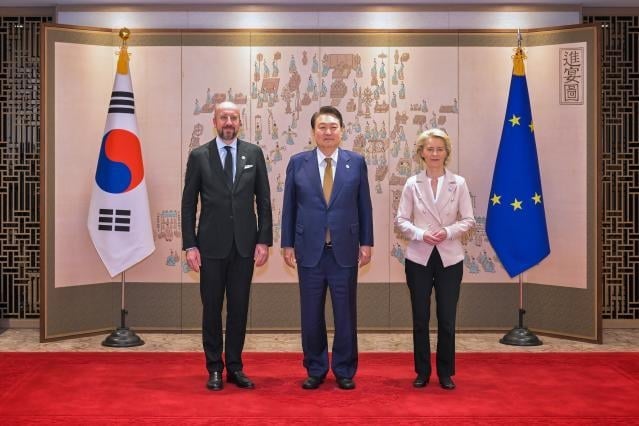On March 15, 2022 the EU adopted new measures, what are they?
The EU adopted today a fourth package of restrictive measures against Russia in response to its brutal aggression against Ukraine and its people. These sanctions will further ramp up economic pressure on the Kremlin, and undercut its technological base and curtail its ability to finance its invasion of Ukraine.
The agreed measures are the following:
- A full prohibition of any transactions with key Russian State-owned enterprises across different sectors – the Kremlin’s military-industrial complex.
- An EU import ban on those steel products currently under EU safeguard measures, amounting to approximately € 3.3 billion in lost export revenue for Russia. Increased import quotas will be distributed to other third countries to compensate.
- A far-reaching ban on new investment across the Russian energy sector, with limited exceptions for civil nuclear energy and the transport of certain energy products back to the EU.
- An EU export ban on luxury goods (e.g. luxury cars, jewellery, etc.) to directly hit Russian elites.
- A ban on the rating of Russia and Russian companies by EU credit rating agencies and the provision of rating services to Russian clients, which would result in them losing even further access to the EU’s financial markets.
- The list of sanctioned persons and entities has been further extended to cover 15 more individuals and 9 more entities. Altogether the list now apply to a total of 877 individuals and 62 entities.
- The EU, together with other World Trade Organization (WTO) members, agreed today to deny Russian products and services most-favoured-nation treatment in EU markets.
Why are State-owned banks, railways and the maritime shipping register partly excluded from the prohibition on transactions?
When imposing specific sanctions, the EU selects the most appropriate and targeted measures to achieve the goals pursued by the sanctions regime. It also takes into account possible indirect effects on EU operators complying with the measures. In this case, the EU considered that the measure was most effective by selecting specific transactions with certain State-owned companies. In any event, EU sanctions are scalable and, as the intense activity of the past weeks shows, they are scaled up depending on the situation on the ground.
Will the United States also ban Russian companies from their credit rating agencies?
This EU measure has been coordinated closely with international partners. It is for the United States to announce the exact measure they will be adopting.
What steel products are covered? Are iron products covered?
The list of steel products covered is referred to in Annex 2 of the Amending Regulation, as published in the Official Journal of the EU. Iron products are not covered.
Why did you not fully ban investment in the Russian energy sector?
The investment ban on the Russian energy sector is far-reaching and comprehensive. Yet, some transactions are needed to ensure the supply of certain energy products into the EU. To ensure close scrutiny, such investments are subject to prior approval from the national competent authorities in the EU.
What luxury goods are covered by the ban? Are there any thresholds? How will they be implemented?
The ban covers a large range of luxury goods, from luxury cars to products for domestic use to watches, to give a few examples.
There are different thresholds depending on the category of luxury goods, so that the ban does not hit the more regular needs of the population in Russia. The minimum threshold is €300.
The ban will be implemented by the EU’s customs authorities: banned products are not allowed to be exported to Russia.
Does the ban on luxury goods also cover imports from Russia (such as caviar or vodka)?
No, the focus of this package of sanctions is on depriving Russia from EU luxury goods.
How will the EU avoid the risk of circumvention of banned products via third countries? Will the EU introduce further trade restrictions in the future?
Under the current Regulation, there is already a clear prohibition from circumventing the restrictive measures including via third countries. It constitutes a violation of sanctions.
What are you doing to prevent oligarchs from using crypto assets to circumvent sanctions?
The sanctions package adopted on 9 March 2022 fully clarifies that crypto assets fall under the scope of “transferable securities”. It also confirms the common understanding that loans and credit also include crypto assets. These clarifications will help ensure the proper implementation of the restrictions in place.
The circumvention of the restriction on some banks to use SWIFT is theoretically possible via crypto-assets or by other means. However, it is not immediately possible to do so in a timely and efficient manner. Markets are broadly aware of this. At first sight, it might be that the use of crypto to avoid sanctions is more relevant for our restrictions on capital outflows from Russia.
While sanctions evasion via crypto currencies is harder to detect in the first place, once detected it is easy to investigate because crypto transactions are fully traceable and it is practically impossible to alter that.
If and when large amounts of crypto assets are converted to fiat currencies (and vice versa), these transactions will fall under anti-money laundering due diligence rules.
We continue to constantly monitor the market situation. Any indications for non-compliance with the sanctions will be looked at by the relevant authorities in the Member States.
What are the consequences of denying Russia most-favoured-nation (MFN) status?
Removal of MFN status means suspending the benefits that come from being a WTO Member, more specifically the benefit of not being discriminated against by other Members. For example, MFN treatment guarantees that a Member will not be subject to higher tariffs than other Members, or to import bans that do not apply to other Members. Suspension of MFN treatment means that the Member concerned – in this case Russia – may be subject to higher tariffs and import bans.
The EU has decided to act not through an increase on import tariffs, but through set of sanctions that comprise bans on the imports or exports of goods, as this is much quicker and more effective than preparing a completely new tariff schedule from scratch.
In practice, the EU has already removed a number of trade benefits that Russia previously enjoyed through the imposition of sanctions. Additionally, the EU has restricted the provision of SWIFT financial services to certain Russian banks, which constitutes a disapplication of MFN vis-à-vis Russia under the General Agreement on Trade in Services (GATS). Today’s sanctions remove further trade benefits from Russia.
President von der Leyen said that Russia’s financing by leading multilateral and international financial institutions would be suspended. Which institutions are they?
The institutions consist of the International Monetary Fund, the World Bank Group, the European Bank for Reconstruction and Development (EBRD), and the Organisation for Economic Co-operation and Development (OECD). While Russia’s membership of these institutions cannot often be suspended as such, the EU is working with its international partners to prevent Russia from obtaining financing from these institutions. For example, the EU is working with its partners to make sure that the EBRD suspends Russia and Belarus’ access to EBRD finance and expertise.
Can you tell us more about the International Task Force that has been set up to coordinate action on sanctions?
As announced by the G7, an International Task Force has started its work on sanctions implementation, for example the enforcement of asset freezes against listed individuals. Within the Commission, Commissioner Reynders leads the “Freeze and Seize” Task Force, which coordinates work done at national level by law enforcement authorities, prosecution services and judicial authorities, to identify, freeze and, where possible, confiscate assets of Russian and Belarussian individuals subject to EU sanctions. The Commission’s Task Force seeks coordinated actions between Member States, Eurojust and other agencies, such as Europol and eu-LISA. It works closely with international partners, including the International Task Force.












